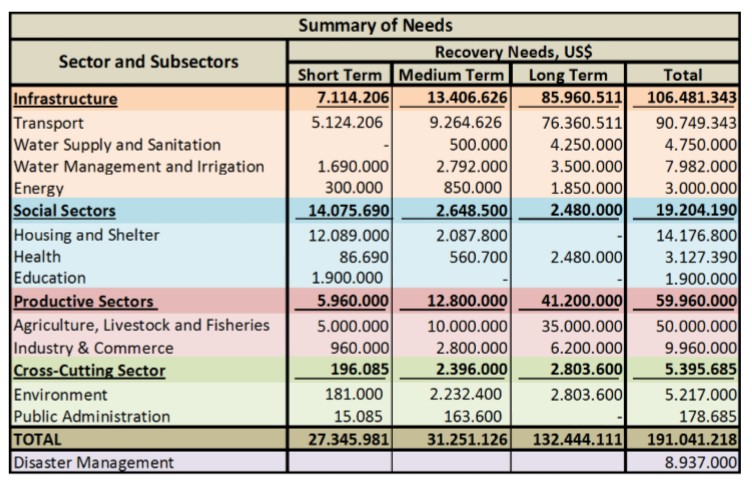INTRODUCTION
The fifth step is to identify the priority recovery sectors and projects, which are consistent with the results of the post-disaster needs assessment and the previous steps. The lead agency can identify the main sectors (such as health, agriculture, transportation) which are most-affected by the disaster and which have the largest negative impact on the local population and economy. Through consultations with government departments and civil society stakeholders, a long-list of recovery project titles in each priority sector can be prepared and prioritized with agreed criteria. After agreement of the priority recovery projects, the recovery ‘outputs’ drafted in Step 3 can be reviewed and updated if necessary.
IDENTIFY THE PRIORITY SECTORS FOR RECOVERY
In order to identify the priority development sectors for post-disaster recovery, the lead agency should refer to a) the results of the post-disaster needs assessment (if undertaken), b) the recovery vision, impacts, outcomes, outputs, c) the recovery strategic framework and policies. Previous experience indicates it is very important that the priority sectors for recovery are based on these previous steps.
The following example of post-disaster recovery needs is from the ‘Cambodia Post-Ketsana Disaster Needs Assessment’. The needs helped the agencies involved identify the priority sectors for recovery – along side the overall recovery framework.
Source: Royal Government of Cambodia (2010)
The answers to the following questions may also help identify the priority sectors for recovery:
- What sectors are the main contributors to the economy?
- What sectors employ the most number of people?
- What sectors are critical in providing inputs to other sectors?
- Which social groups have historically been neglected after disaster?
- What are the immediate human needs for recovery such as housing, food sufficiency, water and sanitation, health, livelihoods, transport, power, communications, livelihoods, tourism, social protection and governance?
- What are the longer-term needs like risk reduction, environmental regeneration, etc.?
IDENTIFY THE PRIORITY PROJECTS FROM ACROSS THE PRIORITY SECTORS
Recovery activities are intended to bring back normalcy to all disaster-affected areas and sectors as soon as possible. Based on the results of Step 3 and the identified priority sectors, specific programs and projects can be selected as priority activities to bring about the outputs of the recovery plan. Through consultations with government departments and civil society stakeholders, a long-list of recovery project titles in each priority sector can be prepared and prioritized.
According to the “Guide to Developing Disaster Recovery Frameworks” (2014), the following can be used as a set of criteria in project prioritization:
- Potential for direct and widest humanitarian impact;
- Pro-poor, pro-vulnerable and gender-sensitive agendas;
- Sustainable livelihood generation potential;
- Balance between public and private sector recovery;
- Balance between physical infrastructure reconstruction and less visible recovery (such as capacity building and governance), and;
- Restoration and rebuilding of critical infrastructure and services.
Example: Recovery Activities in the Agriculture Sector
For example, considering that a greater number of people, especially the poor, are engaged in agriculture, it is could be one of the sectors that should be prioritized.
Some of the possible recovery related activities (programs and projects) are:
1. Direct subsidy on fertilizers, seeds and pesticides to poor farmers or production credit to enable farmers to buy inputs and enable them to re-plant.
2. Food-for-work or a combination of cash-for-work to rehabilitate/reconstruct damaged irrigation systems, public schools, health centers, and other off-farm sources of income that can provide temporary employment while farmers are waiting to plant and harvest.
3. Dispersal of livestock and poultry to replace the depleted stocks.
4. Urgent repairs of agriculture-related facilities such as irrigation, storage, markets, etc.
5. Reconstruction and repair of irrigation systems, post-harvest facilities, markets and other structures under a building-back-better strategy.
On the other hand, to complement the quick recovery of agriculture, the repair of power and water supply, roads, bridges, airports, ports and other important facilities can be initiated.
